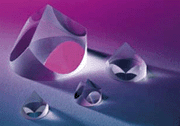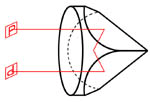Corner Cube Retroreflector
|
Retroreflectors are sometimes called corner cubes because the reflecting surfaces are three mutually perpendicular faces like the corner of a cube. Light entering a retroreflector is reflected back 180° and parallel to the original beam, regardless of its orientation to the beam. This makes retroreflectors valuable for applications requiring an exact 180° reflection without having to precisely orient the prism. Reflected images are both inverted and reversed.
|
|
Corner Cube Prisms are designed to reflect any ray or beam entering the prism face, regardless of the orientation of the prism, back onto itself. A mirror will only do that at the normal angle of incidence. As a result, corner cubes are ideal where precision alignment is difficult or time-consuming. Retroreflectors will function even at very large angles of incidence. There are three total internal reflections within the corner cube. For its special performance, it is often used to the distance measurement, optical signal process and laser interferometer.
|
  |
|
Apollo Lunar Ranging Targets
Apollo astronauts carried arrays of precision corner cubes to the lunar surface. Powerful lasers are directed at the moon through telescopes on earth. The corner cubes reflect the laser beams back to their origins. Astronomers can make extraordinarily accurate measurements of the lunar distance by timing the round trip of pulses of laser light between the earth and the moon.
|

|
|